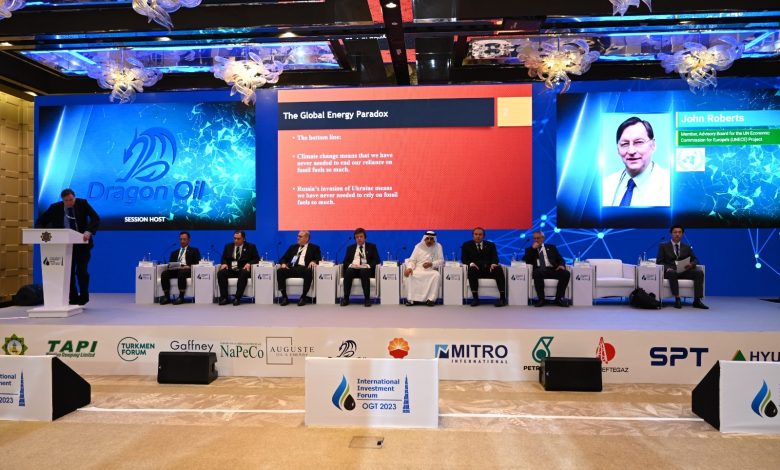Turkmenistan calls for more oil and gas investments

Discussions on the last day of the International Forum for Attracting Foreign Investment in the Turkmen Energy Sector focused on the investment opportunities available to Turkmenistan, especially in the Caspian Sea region, in light of the attractive investment laws enacted by the Turkmen government and the economic advantages granted to foreign companies wishing to enter the Turkman market.

During the various sessions, the participants explained that the Turkmen market still has important investment opportunities in the oil and gas sector and renewable energies, especially since the world needs more investments in oil and gas exploration to meet the growing demand for energy in the future with the rising population around the world.
“Thanks to the political and economic stability and the ‘open doors’ policy in the country, all the necessary conditions have been created to ensure a favorable investment climate for the implementation of oil and gas projects, as Turkmenistan is the largest player in the oil and gas market in the region,” said Guvanch Agajanov, Chairman, State Concern “Turkmennebit”
and Asia, that the total hydrocarbon resources of the Turkmen sector of the Caspian Sea amount to 18.2 billion tons of oil equivalent.
“Today, the main role in the oil industry belongs to our country, as it is the body entrusted with developing this industry, implementing a unified policy in the field of oil production and refining, producing new petrochemical products, marketing them in the local market and exporting them abroad,” Guvanch added.

He explained that the government-owned “Turkmennebit” company manages the production, transportation and processing of oil and condensate gas, and it is the owner and user of the final products of oil and gas refining, and it disposes of it according to its status.
The spokesman pointed out that the main activity of the company is currently concentrated in western Turkmenistan, as there are oil assets in more than 30 fields, which are in various stages of development. The number of operating oil and gas wells is more than 2,300 units, pointing out that a feature of the oil and gas fields in western Turkmenistan is the presence of tectonic defects and a multi-layered structure, which includes up to dozens of individual deposits, which requires great efforts to develop each field using innovative technologies. modern.
Guvanch touched on the quality of the Turkmen oil and gas fields, which contributes to increasing production and the quality of Turkmen products with a low cost of extraction, pointing out that modernizing production methods and using modern technologies and high-efficiency equipment increases the capacity of the fields, as the depth of the oil well reaches 7000 meters, indicating that this The safety and strength of the approach adopted by the Turkmen company in cooperation with American companies with a global reputation, as is the case with the Chinese company UPS and Synoptic.
According to Guvanch, his company intends to increase cooperation with foreign companies and international partners who are ready to offer new and highly promising methods of geological exploration, advanced technologies in the field of drilling horizontal wells, and developing sediments with mining conditions and difficult geological conditions.
Guvanch addressed the legislative aspect in Turkmenistan related to the exploration, production and processing of hydrocarbon resources, which aims to ensure the rational use of hydrocarbon resources and the preservation of Turkmenistan’s natural resources for future generations.

He continued, “This law acts as an additional guarantee and a powerful legal and regulatory tool to attract large foreign capital to the country, and thus creates prerequisites for the effective development of the country’s vast hydrocarbon resources.”
For his part, Ali Rashid Al Jarwan, CEO of Dragon Oil, revealed that the company is currently working on evaluating the suitability of investing in clean energy in Turkmenistan in terms of economic evaluation and evaluating the opportunities available there.
Al-Jarwan explained that Dragon Oil’s business in Turkmenistan will focus on operational excellence, enhancing oil recovery, re-injecting gas and reducing flaring. At the same time, the company plans to reduce carbon inefficiency and enhance gas utilization through preventive maintenance, leak detection, replacement of leaking equipment and pipelines, and the use of the best available technologies. To improve energy efficiency and asset integration.
Al-Jarwan said that the world will consume more energy in 2050 than it consumes today, as fossil fuels will remain necessary until 2050, explaining that, based on the estimates of most international oil companies, oil and natural gas will constitute 20%-55% of the global energy mix in 2050. It is expected that renewable energy sources will mostly replace coal and a small percentage of oil.
Al-Jarwan expected an increase in the demand for natural gas, to a large extent, to help meet the growing needs for electricity, at the same time, technology will continue to play a vital role in shaping the energy mix in the future, pointing out that the recent rise in oil and gas prices highlights the importance of a gradual shift towards Renewable energy.
According to Al-Jarwan, the disruption in global energy supplies resulting from the Russian-Ukrainian war reinforces the proposition of a triple treatment of the energy equation, which is security, affordability, and sustainability. Energy security increases the demand for locally produced renewable energy sources and cleaner fossil fuels.
Al-Jarwan touched on the changes in the energy sector through the introduction of modern technology that is also supported by government regulations with the aim of reducing carbon emissions and achieving climate neutrality, referring to the efforts made by countries around the world to reduce emissions by storing carbon dioxide emissions.
Al Jarwan sees declining demand for oil in the long term, driven by declining use in road transport as vehicle efficiency improves and vehicle electrification accelerates. However, oil will continue to play a major role in the global energy system over the next 15-20 years.
For oil producers, Al-Jarwan believes that since oil and gas prices are still uncertain in the near future, production costs will be a decisive criterion. Pointing out that the use of the latest technologies to increase productivity and a fast government approval cycle are essential factors for achieving efficiency.
For his part, Mark Robinson Regional Director Europe, Africa and the Middle East at Gaffney Klein Company, which specializes in consulting, said that his company is finalizing a contract with Turkmenistan to provide advisory support to enhance the marine spaces of the Caspian Sea. Mark said: “The global energy companies have a great opportunity.” To enter Turkmenistan for further development of the hydrocarbon market and exports, “expecting to schedule promotional tours and other events in 2023.”

In the same time, Irina Luryev, the head of the laboratory of the Scientific Research Institute of Natural Gas of the State Concern “Turkmengas” said at the International Forum on attracting investments in the energy sector of Turkmenistan in Dubai yesterday:” In the future, with the implementation of seven stages of development of the giant Galkynysh field, the annual production of natural gas will reach about 200 billion cubic meters of “blue fuel”.
The Galkynysh field is at the stage of pilot operation and in the future the rate of gas withdrawal will increase, – Luryeva said. – At present we are at the first stage of development of the field. During the continuous withdrawal period, it is planned that annual gas production from the entire field will reach about 200 billion cubic meters.
At this stage of the exploration of the Galkynysh field, the forecast calculations of development indicators provide for 7 development stages, the speaker continued, noting that within the first stage of the field development, the operating stock of production wells is 51 units. More than 10 wells are under active drilling.
It was also noted that the average design gas flow rate is 1.5 million cubic meters per day, and the potential of the reservoir allows for a long time to operate wells with a flow rate of more than 2 million cubic meters per day.
“According to our forecasts, made jointly with GaffneyCline, the period of constant gas withdrawal for each stage will be more than 30 years,” I. Luryeva noted.
The report noted that at present, at the Galkynysh field, specialists from the Branch of the Chuanqing Drilling Engineering Company at CNPC in Turkmenistan have completed the construction of three new gas wells, the design of which differs from the rest of the wells of the 1st stage. The original design and correct placement of these wells made it possible to achieve a design gas flow rate of about 3 million cubic meters per day, which is stably maintained throughout the entire period of their operation.
As emphasized, it is clear that the development of the unique Galkynysh gas field requires continuous improvement of applied technologies and strategies, special detailed and laboratory experiments, comprehensive environmental and economic in-depth study, innovation and investment.
Therefore, Turkmen specialists welcome the exchange of views, experience, achievements and know-how of other companies in the field of research and development of such deposits.











